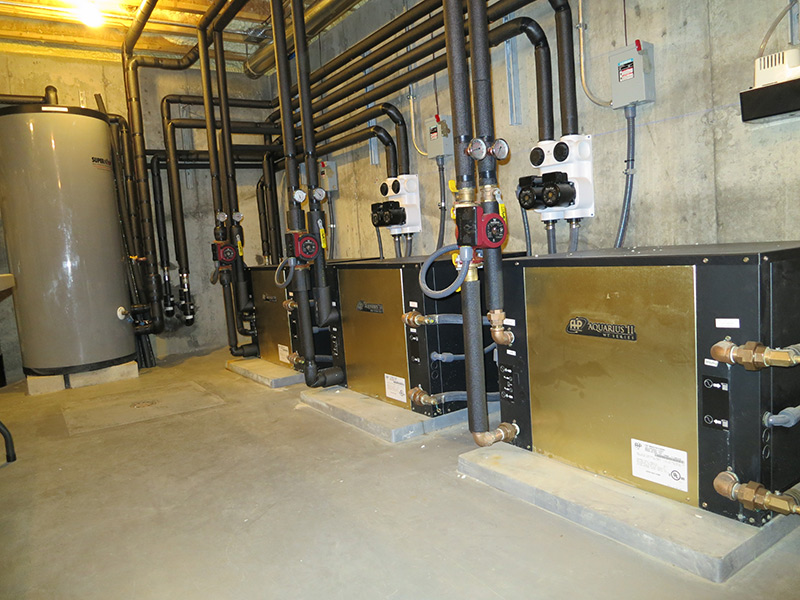
Geothermal Systems
Please note: we do not sell or install Geothermal Systems, this is strictly an informational page for educational purposes.
Geothermal heat pump systems move energy from a heat source to a heat sink and very little heat is actually produced from either fossil fuels or electricity. The GSHP uses electricity to run circulator pumps, fans and compressors to move the heat. This results in a minor increase in electricity costs with a major reduction in fossil fuel costs. The same equipment can be used to heat in winter and cool in summer by reversing the flow of heat transfer.
How does it Work?
Geothermal technology utilizes a heat pump and a series of high strength plastic pipes buried in the ground, either horizontally or vertically. These systems can be open or closed loop systems. Open loop systems use ground water (well, pond, stream) as the heat/cooling source which is fed to the heat pump and is then discharged back to the ground. Open loop systems have higher pumping requirements and can cause water usage and environmental problems but can be significantly less expensive. Closed loop systems circulate a water/glycol solution with low energy pumps but typically require longer pipe lengths and more extensive drilling and trenching for an equivalent amount of heat transfer, and are therefore typically more expensive. Using the earth as a heat source and heat sink, polyethylene pipes circulate the water/antifreeze solution from the earth to the heat pump, cooling the solution in summer and warming the solution in winter. For summer cooling, the heat pump functions like an air conditioner transferring heat from the air in the building to the water/glycol solution via a compressor and air-to-water heat exchanger. For winter heating, the process is reversed and the heat pump transfers heat from the ground sourced solution to the building air via a compressor and water-to-air heat exchanger. The same systems can be used to provide heat for domestic hot water, forced hot air, and hydronic radiant floor space heating systems.
What is Included in a Geothermal System?
 A geothermal ground sourced heat pump is a variation of a traditional air source heat pump found in most of today’s residential air conditioning systems. The cooling or air-conditioning unit (typically located indoors) consists of several primary components: a compressor driven by an electric motor, a condenser coil with tubing for water flow and tubing for refrigerant flow, a circulation pump that moves water through the condenser coil and outdoor water loop, an expansion device that lowers system pressure, an evaporator coil with tubing and many fins to cool and dehumidify air, an indoor fan to circulate air over the cold evaporator tubing and fins, a refrigerant fluid to operate at the needed pressures and temperatures.
A geothermal ground sourced heat pump is a variation of a traditional air source heat pump found in most of today’s residential air conditioning systems. The cooling or air-conditioning unit (typically located indoors) consists of several primary components: a compressor driven by an electric motor, a condenser coil with tubing for water flow and tubing for refrigerant flow, a circulation pump that moves water through the condenser coil and outdoor water loop, an expansion device that lowers system pressure, an evaporator coil with tubing and many fins to cool and dehumidify air, an indoor fan to circulate air over the cold evaporator tubing and fins, a refrigerant fluid to operate at the needed pressures and temperatures.
A geothermal heat pump is merely an air-conditioner with one extra valve that allows the condenser (hot coil) and evaporator (cold coil) to reverse places in the winter. Thus the latent heat of the warm, ground sourced water, by reversing the condenser-evaporator function, produces hot water to warm the air circulated by the indoor fan. After passing through the expansion device, the refrigerant enters the outdoor coil at a low temperature. Because the temperature of the refrigerant is low, heat can be transferred from the water to the refrigerant inside the evaporator. If the ground sourced water loop is properly sized, the heating efficiency is exceptionally high compared to conventional systems. With the addition of a water-to-water heat exchanger, the basic geothermal heat pump can be adapted to provide for domestic hot water and hydronic radiant floor heating systems.
Is Geothermal Right for Me?
Despite all the positive publicity on GHPs, they are not for everyone. Like any other heating and cooling system, GHPs tend to fit well in certain circumstances and poorly in others. Familiarizing yourself with the factors that affect the feasibility of GHPs will assist you in making an informed decision as to their suitability for your home.
A proper evaluation of your site is vital to ensuring that your system will perform as expected. Key cost factors include building heat, air conditioning and hot water loads, ground and soil heat transfer characteristics, drilling and excavation costs, and underground pipe lengths.
If you would like to further explore your options with regard to Geothermal systems simply give us a call or send us an email. We will schedule an appointment to visit your site in order to perform a thorough evaluation of your potential renewable resource. The design team at RES-TEC will generate a basic system design, and provide a proposal showing the estimated system cost, expected annual system performance estimate, carbon foot-print reduction calculation, and system pay-back times. We provide this service at no charge to our valued customers and look forward to working together with you to bring more Green Energy to the Green Mountains!
CONTACT US TO LEARN MORE TODAY
Please fill out and submit the Free Estimate Form to receive our competitive solar panel quote. Once we receive your request, we will contact you with further assistance.
We will not give or sell your information to any 3rd party.
